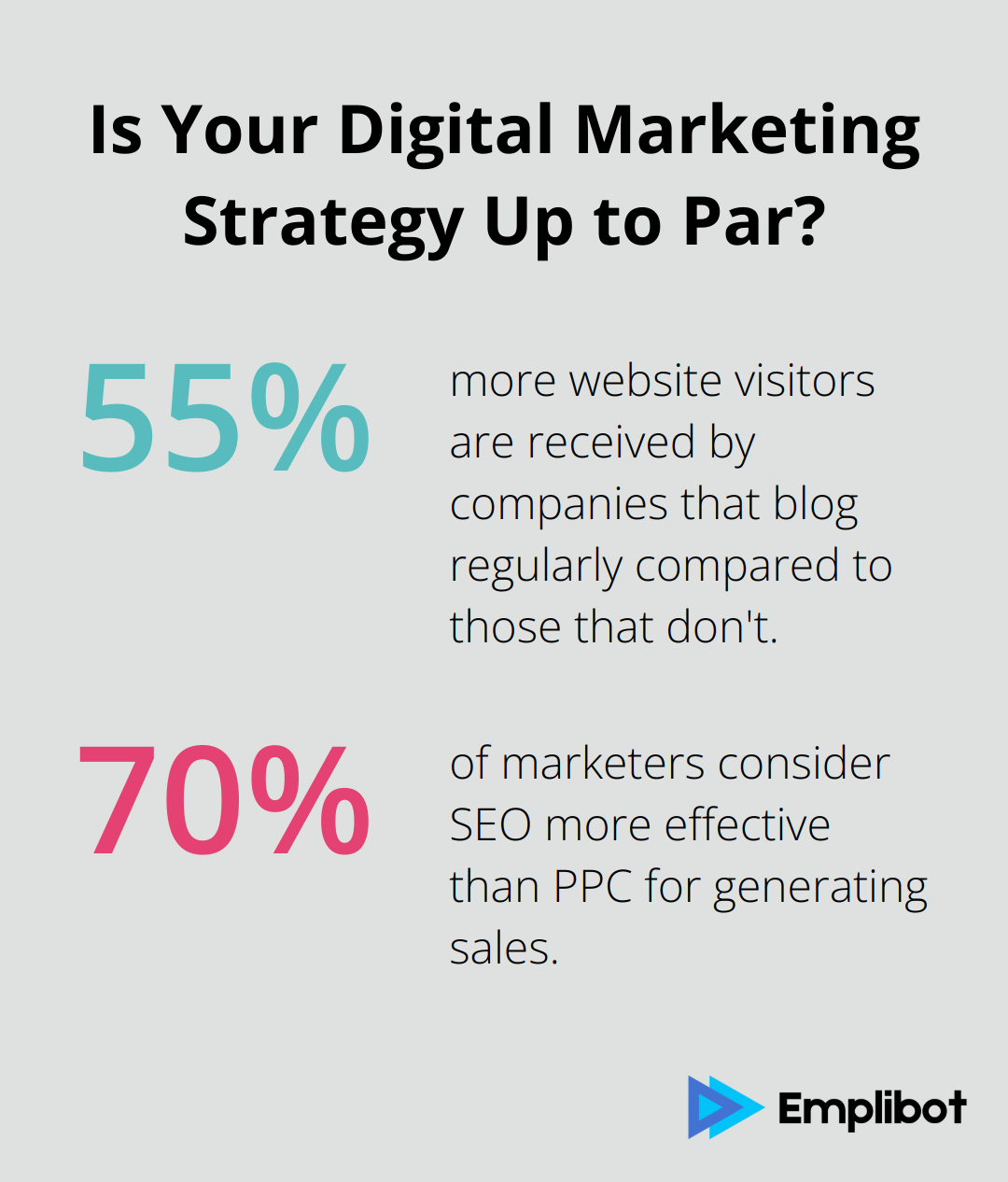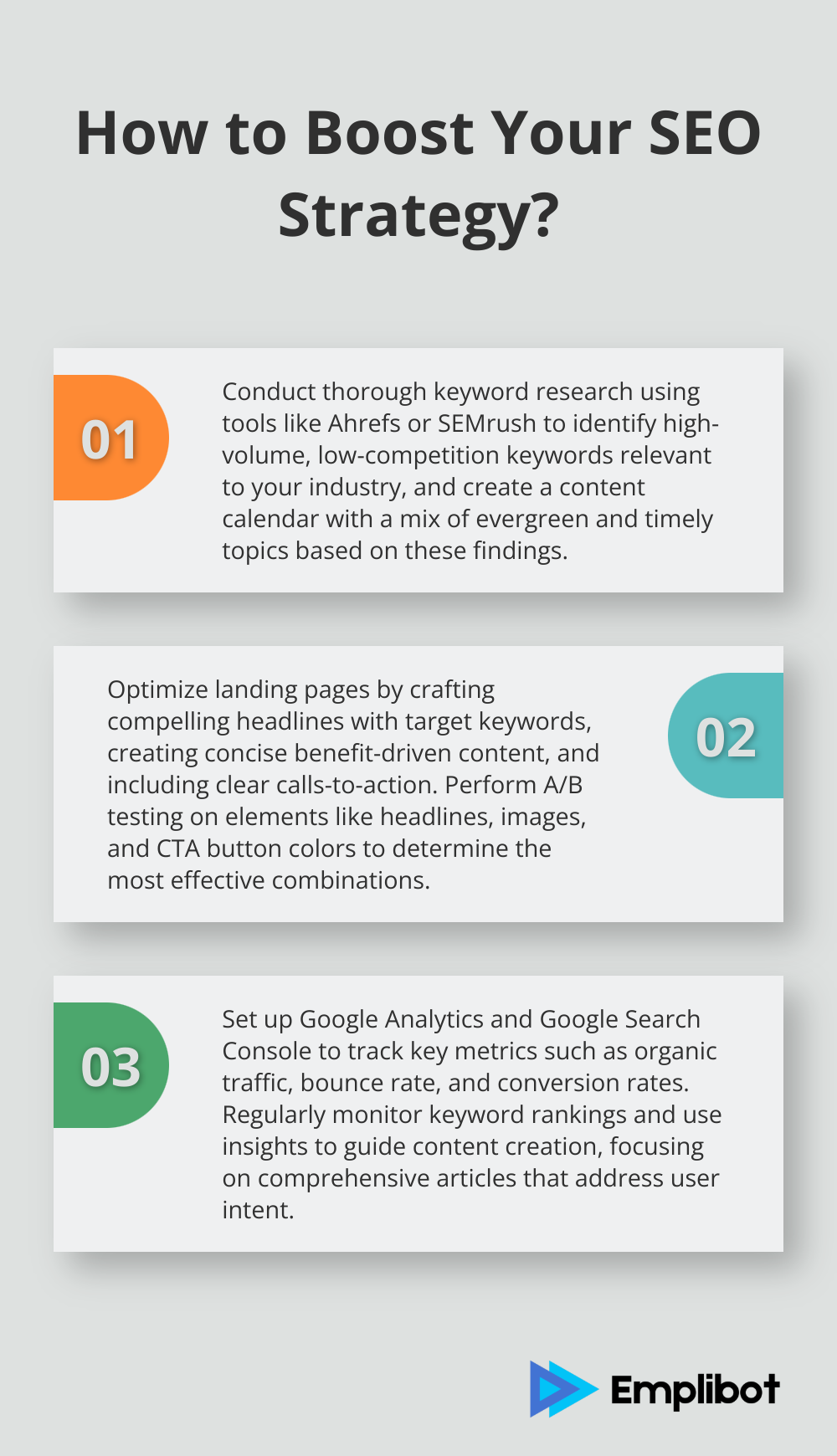Inbound marketing SEO is revolutionizing how businesses attract and engage customers online. At Emplibot, we’ve seen firsthand how this powerful combination can transform digital marketing strategies.
By aligning SEO techniques with inbound marketing principles, companies can significantly boost their online visibility and lead generation efforts. In this post, we’ll break down the key components of inbound marketing SEO and provide actionable strategies for implementation.
Contents
ToggleWhat Is Inbound Marketing SEO?
The Power of Combining Strategies
Inbound marketing SEO unites two essential digital marketing approaches. It creates valuable content that attracts potential customers and optimizes it for search engines. This combination enhances site credibility, improves rankings, attracts traffic, and fosters trust and authority, thereby driving successful business outcomes.

Inbound marketing attracts customers through helpful, relevant content. SEO ensures this content is easily discoverable by the target audience. Together, these strategies create a powerful cycle of attraction and engagement.
A HubSpot study found that companies which blog regularly receive 55% more website visitors than those that don’t. This traffic increase directly links to the SEO benefits of consistent, high-quality content creation.
Meeting Customers at the Right Moment
Inbound marketing SEO excels at meeting potential customers where they are in their buying journey. Content alignment with specific search queries increases visibility and provides value at the right moment.
As of January 2024, Google’s desktop search engine market share was 81.95%. This statistic highlights the importance of optimizing inbound content for search engines.
Tracking Success and ROI
Inbound marketing SEO offers clear measurability (a significant advantage). Tools like Google Analytics track key metrics such as organic traffic, conversion rates, and engagement levels.
A Databox survey found that 70% of marketers consider SEO more effective than PPC for generating sales. This effectiveness translates into a higher return on investment compared to traditional outbound marketing methods.
Automating the Process
Automation tools streamline inbound marketing SEO implementation. These platforms handle tasks from keyword research to content creation and optimization, making it easier for businesses to harness this powerful approach.
As we move forward, let’s explore the key components that make inbound marketing SEO so effective in driving online success.
What Makes Inbound Marketing SEO Effective?
Content That Converts
The foundation of effective inbound marketing SEO is high-quality, engaging content. This content should address the needs and interests of your target audience, providing real value at every stage of the buyer’s journey. Content marketing costs 62% less than traditional marketing channels, and these leads are 6 times as likely to convert.

To create content that converts, develop a comprehensive content strategy. This strategy should outline your target audience, key topics, content formats, and distribution channels. Focus on creating a mix of content types (blog posts, whitepapers, case studies, and videos) to cater to different preferences and stages of the buying process.
Keyword Strategy for Maximum Impact
Keyword research and targeting are essential components of inbound marketing SEO. Identifying and incorporating relevant keywords into your content improves your visibility in search engine results pages (SERPs) and attracts more qualified traffic to your website.
To develop an effective keyword strategy, use tools like Google Keyword Planner or SEMrush to identify high-value, low-competition terms. Focus on long-tail keywords, which are more specific and often have higher conversion rates. A study by Ahrefs found that long-tail keywords (4+ words) have a 3-5% higher click-through rate than shorter keywords.
Building Authority Through Links
Link building helps establish your website’s authority and credibility in the eyes of search engines. Acquiring high-quality backlinks from reputable websites in your industry improves your search engine rankings and drives more organic traffic to your site.
To build authority through links, create linkable assets such as original research, infographics, or comprehensive guides. Reach out to industry influencers and relevant websites to share your content and earn backlinks. A study by Backlinko found that the number one result in Google has an average of 3.8 times more backlinks than positions 2-10.
Technical SEO for Peak Performance
While content and keywords are essential, technical SEO elements play a vital role in ensuring your website performs optimally in search engines. These elements include site speed, mobile responsiveness, URL structure, and schema markup.
To improve your technical SEO, conduct a comprehensive site audit using tools like Google Search Console or Screaming Frog. Address any issues identified, such as broken links, duplicate content, or slow-loading pages. Google reports that decreasing mobile site load times by just one tenth of a second resulted in major performance gains, with conversion rates increasing by 8.4% for retail sites.
Implementing these key components of inbound marketing SEO significantly improves your online visibility, attracts more qualified leads, and drives business growth. The next chapter will explore practical strategies to put these components into action and maximize your inbound marketing SEO efforts.
How to Implement Inbound Marketing SEO
Craft a Content Strategy That Ranks
The first step in implementing inbound marketing SEO involves the development of a content strategy that aligns with your SEO goals. Start with thorough keyword research to identify topics your target audience searches for. Tools like Ahrefs or SEMrush help uncover high-volume, low-competition keywords relevant to your industry.

After identifying your target keywords, create a content calendar that outlines topics, formats, and publication dates. Try to include a mix of evergreen content and timely pieces that address current industry trends.
Optimize Landing Pages for Conversion
Landing pages play a key role in converting visitors into leads. To optimize your landing pages for both search engines and users, focus on creating compelling headlines that incorporate your target keywords.
Make sure your landing page content is concise, benefit-driven, and includes clear calls-to-action (CTAs). A/B testing different elements of your landing pages (such as headlines, images, and CTA button colors) helps identify the most effective combinations.
Harness Social Media for SEO Boost
While social media signals don’t directly impact ranking factors, they can indirectly influence your SEO performance by increasing brand visibility and driving traffic to your website. Share your content across relevant social platforms to expand its reach and encourage engagement.
Include share buttons on your blog posts and landing pages to encourage social sharing. Additionally, use social media to build relationships with industry influencers who can help amplify your content and potentially provide valuable backlinks.
Measure and Refine Your Strategy
To ensure the success of your inbound marketing SEO efforts, regularly measure and analyze your performance. Set up Google Analytics and Google Search Console to track key metrics such as organic traffic, bounce rate, and conversion rates.
Pay close attention to your keyword rankings and adjust your strategy as needed. Tools like SEMrush or Moz help you monitor your rankings and identify opportunities for improvement. Use these insights to guide your content creation efforts, focusing on comprehensive, in-depth articles that thoroughly address user intent.
Final Thoughts
Inbound marketing SEO has become essential for businesses to thrive in the digital landscape. This strategy combines valuable content creation with search engine optimization techniques to attract, engage, and convert target audiences effectively. The future of inbound marketing SEO will likely focus more on user intent, voice search optimization, and mobile-first indexing.

Businesses should prioritize high-quality, relevant content that addresses audience needs and pain points. Thorough keyword research helps understand potential customer searches, allowing for proper content optimization. Regular publication of fresh content, social media engagement, and continuous strategy refinement based on performance data build a strong online presence.
Tools like Emplibot can streamline inbound marketing SEO efforts, automating various aspects of content marketing. These tools allow businesses to maintain a consistent and effective online presence without overwhelming their resources. Implementing these practices will improve online visibility and customer engagement in the competitive digital marketplace.










 Rated Excellent 4.5
Rated Excellent 4.5